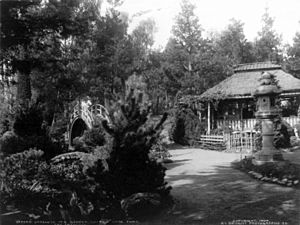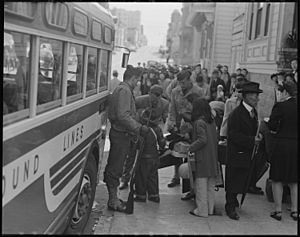History of the Japanese in San Francisco facts for kids
San Francisco and the surrounding San Francisco Bay Area are home to many Japanese American people and people from Japan. The main gathering place for this community is in San Francisco's special neighborhood called Japantown.
Contents
History of Japanese Americans in San Francisco

For a long time, Japan kept itself mostly separate from other countries. People were not allowed to leave easily. But after 1854, when an American, Commodore Matthew C. Perry, arrived, Japan started to change a lot. Many Japanese people began to see the United States as a place with new ideas and opportunities.
Why People Moved to the U.S.
After 1868, Japan changed quickly. Cities grew, and industries developed. This caused problems for farmers and workers. Many lost their jobs because of new competition. They started looking for a better life outside Japan. As wages in Japan went down, news of a strong economy in the U.S. made many want to move there.
The first Japanese immigrants arrived in the San Francisco Bay area in 1869. At first, they settled near San Francisco's Chinatown and the South of Market area.
In 1885, a professor named Yuji Ichioka estimated that about 300 Japanese "school boys" lived in San Francisco. These were young immigrants who worked to pay for their education in the U.S.
Japantown's Beginnings
After the big San Francisco Earthquake in 1906, the Japanese community moved to what is now Japantown in the Western Addition. Some also moved to the South Park neighborhood. In 1900, there were 90 Japanese businesses. By 1909, this number had grown to 545!
After the earthquake, the San Francisco Board of Education made a rule that Japanese American students had to go to separate schools. This caused a big argument with the Japanese government. The problem was solved with something called the Gentlemen's Agreement of 1907. This agreement made it much harder for Japanese people to move to the United States.
San Jose's Japantown
San Jose's Japantown was created because Japanese immigrants needed to work together to survive. It was first known as Heinlenville Chinatown. When the city's second Chinatown burned down, a man named John Heinlen offered his own land for a new location. He built new brick buildings and rented them to Chinese people at low prices. This helped create a new community space.
World War II and Its Impact
During World War II, San Francisco's Japantown was the largest Japanese community outside of Japan. But it became completely empty of its Japanese residents. This happened because of a government order called Executive Order 9066. This order forced all people of Japanese background in the United States to be moved to special camps, known as internment camps. By 1943, many parts of Japantown were empty because people had been forced to leave.
After the war, some Japanese Americans came back. New immigrants from Japan also arrived, and Japanese companies invested in the area. However, many people did not return to Japantown. Instead, they settled in other parts of San Francisco or moved to the suburbs. City efforts to rebuild the neighborhood in the 1960s through the 1980s also changed the area.
A civil rights lawyer named Wayne M. Collins lived and worked in San Francisco. He helped many Japanese Americans with important legal cases until he passed away in 1974. He worked to protect their rights.
Important Organizations
The Fukuin Kai opened in 1877. Many believe this was the very first Japanese organization in the United States. It was an important place for the community.
Education for Japanese Americans
Weekend Japanese Schools
The San Francisco Japanese School (SFJS) is a special weekend Japanese school. It is recognized by Japan's Ministry of Education. The school helps over 1,600 students learn Japanese language and culture. It uses classrooms in four different schools. Two are in San Francisco, and two are in the South Bay.
- For elementary students, classes are held at A.P. Giannini Middle School in San Francisco and The Harker School Blackford Campus in San Jose.
- For junior high and high school students, classes are at Lowell High School in San Francisco and J.F. Kennedy Middle School in Cupertino.
Another official weekend school is the Grossman Academy Japanese Language School. Its offices are in Fremont, and classes are held in Palo Alto.
Saniku Gakuin in Japan also has a weekend school in Santa Clara, California. It's called the Saniku Gakuin Japanese School. Its classes are held at Latimer Elementary School in San Jose.
Kinmon Gakuen is another Japanese language school in San Francisco. It was started in 1911.
Bilingual Programs
Two elementary schools in the San Francisco Unified School District offer special programs. These schools, Clarendon Alternative Elementary School and Rosa Parks Elementary School, teach both Japanese language and culture.
Notable People from the Community
Many Japanese Americans from the San Francisco Bay Area have achieved great things:
- Richard Aoki (1938–2009), a member of the Black Panther Party.
- Ruth Asawa (1926–2013), a famous sculptor known for her wire art.
- Yoshiaki Fukuda (1898–1957), a Konko bishop and missionary.
- Makoto Hagiwara (1854–1925), a landscape designer for San Francisco's Japanese Tea Garden. He is often said to have invented the fortune cookie!
- Hisako Hibi (1907–1991), an artist who painted and made prints.
- Mike Honda (born 1941), a politician who served in Congress.
- Yuji Ichioka (1936–2002), a historian and civil rights activist.
- Hiroshi Kashiwagi (1922–2019), a poet, playwright, and actor.
- Thomas Yamamoto (1917–2004), an artist.
- Wally Yonamine (1925–2011), a multi-sport athlete who played for the San Francisco 49ers.


